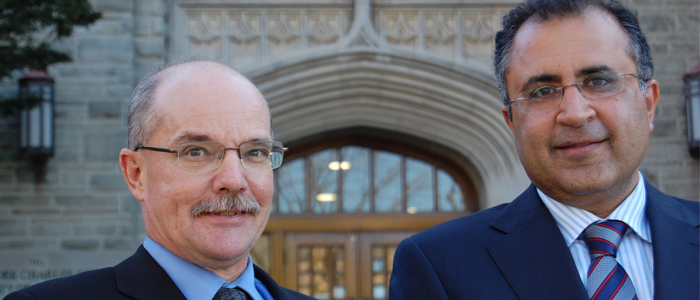Media
Contact
Communications Specialist
Faculty of Engineering
Spencer Engineering Building
Room 2072
Western University
Tel: 519-661-2111 ext. 87015
Email: engineeringcomms@uwo.ca
Western Engineering professors team up with Morrison Hershfield and Ontario Ministry of Transportation

Western Engineering News | December 3, 2012
In preparation for the retirement of experienced bridge design engineers, the Ontario Ministry of Transportation (MTO) is working with Morrison Hershfield and professors from Western Engineering to bridge the knowledge gap.
“MTO identified a need for bridge design training as a refresher for the practicing bridge engineers and for new engineers to support its in-house design initiatives,” explains Maureen Fenlon, Team Lead, Organizational Effectiveness Unit, MTO. “With this need in mind, the Ministry scoped the bridge design course requirements, and selected Morrison Hershfield through competitive process to prepare the course material for MTO.”
Edward Li, Vice President, Transportation and Civil Structures with Morrison Hershfield, explains when the consulting firm agreed to undertake this assignment with MTO, they looked to their past working experience with Western University for training preparation.
“We have been extremely impressed with the knowledge of professors Bartlett and El Damatty and their skill in delivering courses to mature students and working professionals. We were very excited when the two professors agreed to join our team and help us deliver the courses.”
Western’s Civil and Environmental Engineering incoming chair Ashraf El Damatty and professor Michael Bartlett, in partnership with Morrison Hershfield, will lead a total of five training sessions for approximately 80 MTO structural engineers and other MTO staff. To date, four sessions have already been delivered in Kingston, London, North Bay and Toronto. The last session is expected to be held in Toronto in February 2013.
Recently, Bartlett and El Damatty led training workshops in London, Nov. 6-8.
During the training, MTO staff is given insight into current research and development in bridge engineering.
El Damatty and Bartlett created the academic background to the design notes prepared by Morrison Hershfield and MTO senior design engineers reviewed the work to ensure compliance with bridge code, Ministry practices, policies and procedures.
“The binder [of information] can tell you ‘how,’ but not the ‘why.’ The goal of the interactive workshops is to help answer this question,” says El Damatty, noting the experience brought to the discussion by MTO staff provides further learning opportunities.
“In real life, there is often more than one solution,” he says.
The training is part of MTO’s workforce readiness strategy. By bringing in academics and Morrison Hershfield, MTO believes this training model will allow for the best education, knowledge transfer and collaboration.
“I think this training model is terrific because we are combining real-life experience with academics,” says El Damatty. “They now understand key elements in designing different types of bridges they might be exposed to in their careers.”
MTO is focused on strengthening its knowledge base for bridge engineers tasked with maintaining the integrity of the province’s aging infrastructure – all in the face global economic restraint, says Fenlon.
“The Ministry is committed to ensuring its workforce is prepared to meet these challenges while maintaining its role as a leader in innovative bridge engineering. The MTO is proud to have partnered with Western University and Morrison Hershfield to achieve this training objective.”
Li adds, “The course and the design example developed is a comprehensive reference for bridge design tailored for Canadian Code and reflects the Ministry Practice in Ontario today. With the proper training we believe that it could provide background for engineers to develop their design skills, as well as to promote better and more effective communication between engineers.”
The benefits don’t stop with MTO; the more the professors understand MTO’s processes, the more knowledge they are able to transfer to students who will be potentially working in the field, notes Bartlett.
“I do bridge research and MTO is the number one owner of bridges in Ontario,” he says, adding these training sessions will help increase awareness and build relationships with MTO.
This training will enhance the application of the Canadian Highway Bridge Design Code and the development of innovative bridge design solutions, says Fenlon.
“Response from the initial training sessions has been very positive, due in large part to the broad scope of knowledge imparted by the private and academic partners,” she continues. “Ministry participants provided MTO’s perspective, requirements and shared real situations.
“The sessions provided well-rounded and practical training.”

